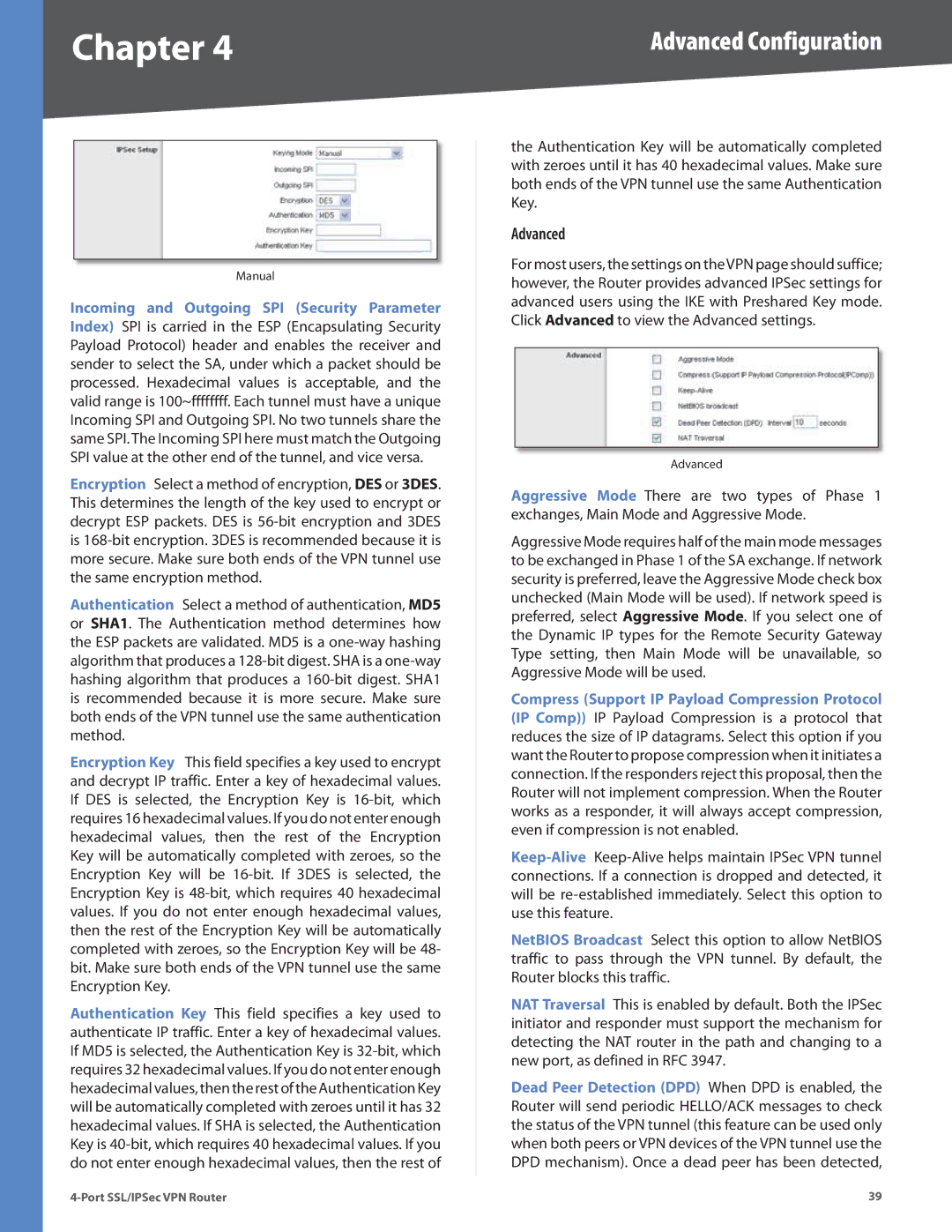
Chapter 4 | Advanced Configuration |
Manual
Incoming and Outgoing SPI (Security Parameter Index) SPI is carried in the ESP (Encapsulating Security Payload Protocol) header and enables the receiver and sender to select the SA, under which a packet should be processed. Hexadecimal values is acceptable, and the valid range is 100~ffffffff. Each tunnel must have a unique Incoming SPI and Outgoing SPI. No two tunnels share the same SPI. The Incoming SPI here must match the Outgoing SPI value at the other end of the tunnel, and vice versa.
Encryption Select a method of encryption, DES or 3DES. This determines the length of the key used to encrypt or decrypt ESP packets. DES is
Authentication Select a method of authentication, MD5 or SHA1. The Authentication method determines how the ESP packets are validated. MD5 is a
Encryption Key This field specifies a key used to encrypt and decrypt IP traffic. Enter a key of hexadecimal values. If DES is selected, the Encryption Key is
Authentication Key This field specifies a key used to authenticate IP traffic. Enter a key of hexadecimal values. If MD5 is selected, the Authentication Key is
the Authentication Key will be automatically completed with zeroes until it has 40 hexadecimal values. Make sure both ends of the VPN tunnel use the same Authentication Key.
Advanced
For most users, the settings on theVPN page should suffice; however, the Router provides advanced IPSec settings for advanced users using the IKE with Preshared Key mode. Click Advanced to view the Advanced settings.
Advanced
Aggressive Mode There are two types of Phase 1 exchanges, Main Mode and Aggressive Mode.
Aggressive Mode requires half of the main mode messages to be exchanged in Phase 1 of the SA exchange. If network security is preferred, leave the Aggressive Mode check box unchecked (Main Mode will be used). If network speed is preferred, select Aggressive Mode. If you select one of the Dynamic IP types for the Remote Security Gateway Type setting, then Main Mode will be unavailable, so Aggressive Mode will be used.
Compress (Support IP Payload Compression Protocol (IP Comp)) IP Payload Compression is a protocol that reduces the size of IP datagrams. Select this option if you want the Router to propose compression when it initiates a connection. If the responders reject this proposal, then the Router will not implement compression. When the Router works as a responder, it will always accept compression, even if compression is not enabled.
NetBIOS Broadcast Select this option to allow NetBIOS traffic to pass through the VPN tunnel. By default, the Router blocks this traffic.
NAT Traversal This is enabled by default. Both the IPSec initiator and responder must support the mechanism for detecting the NAT router in the path and changing to a new port, as defined in RFC 3947.
Dead Peer Detection (DPD) When DPD is enabled, the Router will send periodic HELLO/ACK messages to check the status of the VPN tunnel (this feature can be used only when both peers or VPN devices of the VPN tunnel use the DPD mechanism). Once a dead peer has been detected,
39 |
